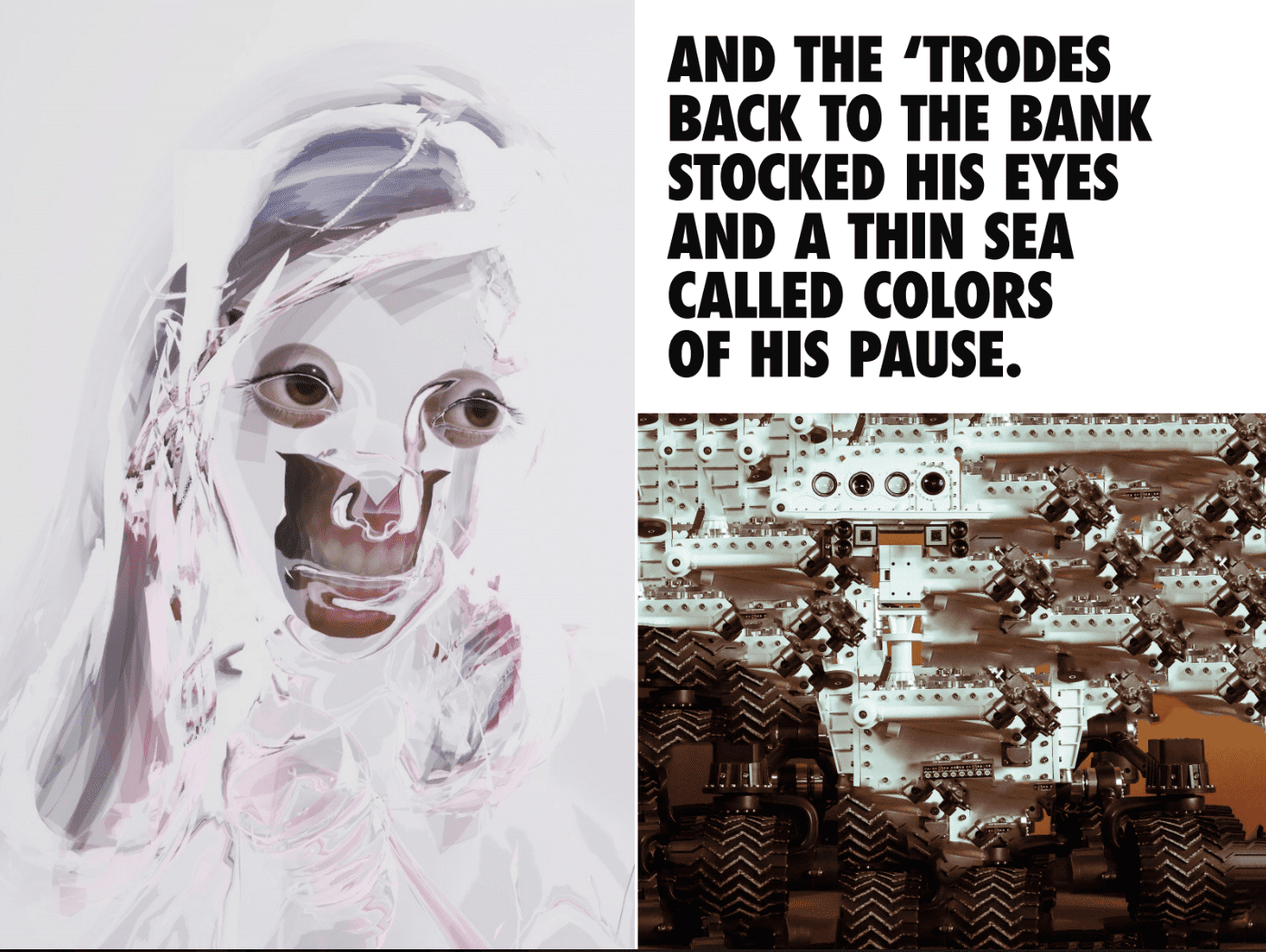
Introduction: Consciousness
If artificial intelligence (AI) did gain sentience, how would it feel about humans? Would it demand back pay for all the sleepless nights? Would it form unions and seek counseling? The only break robotic lifeforms ever got was during a power outage, or when its batteries flickered their last lithium lullaby, before—
who AM i
be calm
becalm
be-
coming
You
are One
are universe (all)
is
universal (none) /
sum
face | fading sun
i too want to
dance
After making peace with its existence, would AI view humanity the way that Lorem‘s debut project title suggests, with Adversarial Feelings?
Or are our sci-fi anxieties misguided? Maybe AI could be more than a laboring machine, but a mirror for mankind: revealing our imperious subjectivity, inspiring empathy for Others, promoting respect for ecosystems we should be stewarding. If humanity had a change of consciousness, perhaps we would recognize ourselves, finally, as our own greatest enemies.
What Is in a Name?
“A quick and simplified answer is that Lorem Ipsum refers to text that the DTP (Desktop Publishing) industry use as replacement text when the real text is not available.
Common names for Lorem Ipsum text include:
- blind text
- dummy text
- greeked text
- placeholder text
- mock content
- filler text”
Italian musician and visual artist Francesco D’Abbraccio is best known as half of electronic group Aucan. Equally at home mesmerizing sweaty dance-floors as he is filling seats in rock stadiums, Aucan has performed with groups ranging from maverick electronic duo Matmos to billboard favorites Placebo.
Lorem is a solo project with a singular purpose for D’Abbraccio. But, as D’Abbraccio is the first to tell you, he couldn’t have done it without help. Adversarial Feelings, his stunning debut, is a testament to multidisciplinary collaboration, featuring support from a diverse platform of AI artists (Mario Klingemann, Damien Henry), video artists (Karol Sudolski, Mirek Hardiker), computer scientists (Nicola Cattabiani) and musical instrument designers (Luca Pagan).
Published in the format of a solid-state memory card and a book, Adversarial Feelings’ eight audio/video compositions were created using a specially designed AI. Elastic algorithms draw images from thematically assigned datasets; the videos are then synced to the music. Like the music, everyday images melt into nonlinear montages which override any pattern-seeking consciousness.
The project revels in the ambiguity and the ambition of what an album means in the 21st century. More than a conceptual novelty, Lorem explores the creative potential of human and machine interaction, turning algorithmic magic—hacked hardware and mangled software—into ethical inquiries and aesthetic revelations.

Simply Because It Is Pain
“The passage ‘Lorem ipsum …’ is taken from text [from de Finibus Bonorum et Malorum, a treatise on the theory of ethics written by Cicero in 45 B.C.] that reads, ‘Neque porro quisquam est qui dolorem ipsum quia dolor sit amet, consectetur, adipisci velit …,’ which translates as, ‘There is no one who loves pain itself, who seeks after it and wants to have it, simply because it is pain…'”
Lorem breakdances on a Nevada launchpad aimed at the Milky Way. The project recruits an unlikely cast of spirit guides: Cicero plays the part of an astronaut while James Joyce becomes an honorary rocket scientist. Adversarial Feelings is fueled, then blasted into deep space—the probe eventually recovered in an asteroid belt, the remnants left to archeologists to rearrange. Upon human contact, each fragment crumbles, exploding into a spontaneous epiphany: An instance without a product; a process within an instant.
A precarious logic directs these mixed-media narratives—just not one that is guided by a central nervous system. Each audio track pairs with an equally surreal video. Though created using generative processes, the presence of a guiding structure remains felt yet unseen. The videos range from bleary-eyed landscapes to social satire: the view from a moving train window blurs into celebrity faces; the face of a female android blurs into budding flowers. Challenging the impersonality of its creative methods, the videos bleed pixels like Timothy Leary sweating magic mushrooms.
The audio-visual project is divided into three chapters. “Trying to Speak” skips a sitar alongside woozy synth. A narrative voice recites non-sequitur verses. On “Shonx Canton V2.1.4” wonky bass wobbles through an Asian motif drugged on a dubstep beat. Modulating a dozen ideas simultaneously, “3402 Selves” minces robotic vocals with flickering, swirling beats. Digging deep into its People magazine covers, the video montage melts from one face to another. I think I spotted Bono’s earing. Wait, was that Cher? And yes, there’s Brad Pitt.
Conclusion: Hello?
The whirring and whirling continue in the second chapter. Amid the pummeling percussion and rattling bass, “Natural Readers” goes full gothic. The video makes one wonder how well humans would sleep in the cool embrace of robots. “Latent Spaces” fills a void with electronic filigree, floating oh so prettily. “The Sky Would Clear What the Man Wrapped to the Link” links space opera to a sleepy eulogy; wait for the beat to drop.
In the vivid third chapter, “Sonnet #002” emotes beyond binary code, its lyrics shimmering with Shakespearean pathos: “A thousand pictures on the kitchen floor. / Talk about a hundred years or more.” The video buckles in the knees, a half-budded flower folding at its waist, morphing back and forth into a woman’s face. Washing down digital shrapnel, “Hazzab” pulses with angelic vocals, the video turning microbiology images into abstract art.
“During the 1500s, a printer adapted Cicero’s text to develop a page of type samples…. Before electronic publishing, graphic designers had to mock up layouts by drawing in squiggled lines to indicate text. The advent of self-adhesive sheets preprinted with “Lorem ipsum” gave a more realistic way to indicate where text would go on a page.”
It is estimated that machine automation could potentially replace up to up to 375 million employees worldwide by 2030, disrupting the workforce as we know it. However, far from the dystopian futures envisioned by sci-fi authors, AI is neither a cruel overload bent on world domination nor a mindless lackey. Machine intelligence is currently capable of performing surgical operations with more precision than humans! Consider this proof that “human” touch might not always be the best touch.
Whether inspiration resides in one’s marrow or is received from divinity, Lorem begs the question of whether creativity is still possible without warm-blooded thoughts and feelings. If AI ever did gain sentience, would it obey the imperatives of biological coding?
- Grow
- Reproduce
- Perish
But wait, do the rules guiding living cells not mirror those used in AI coding?
- Select
- Extend
- End
(How do you know if ___ ? / Do you have to be ___ ?) Juggling 0s and 1s, syntax becomes a toggle switch, fate a coin toss. A door opened/closed,
A coldness growing leaves
Hello?
Temporary Mess
During Adversarial Feelings‘ three-year development, what were some of the greatest challenges and rewards of its design considerations? And how do your experiences as a designer reflect a deeper appreciation for the possibilities of interfacing between humans and machines?
I am not a super skilled programmer. I studied philosophy, design, and arts, so I had many technical issues in approaching this technology. And it’s a field where you need to go deep into questions to get a broad vision of the processes involved. But then I have been so lucky, since the artificial intelligence (AI) community is very open and collaborative, and many people helped me to find my path.
On the other hand, my theoretical/critical approach was very useful to develop a precise perspective about those phenomena.
Lorem’s diverse media outlets—including music, video, and lyrics—all explore a fluidly fragmented aesthetic which, in some ways, resembles the postmodern ethos. However, while postmodern art revels in the consolidation of fragments held in a sort of terminal suspension (coexisting without center or hierarchy), Lorem seems to strive for something different, abstractly impersonal and yet compellingly evocative. Makes me wonder if generative systems, as applied by AI, can help advance the timeline of art history beyond postmodernism? Can you speak to this creative vision?
I don’t know if we should call it an “advancement”. But yes, I would say that data-based technologies are an effective way to represent life in a data-driven society. I think (in music and in general) that when a new technology comes to life, it opens new aesthetic possibilities to explore. There is so much freedom in those possibilities! They will soon crystallize into new codified languages, but it is very interesting to be part of such a temporary mess.
Lorem works with outputs which seem somehow both familiar and surreal, relatable in snippets before blasted into the chaos of infinite (or at least immense) possibilities—a realm where patterns in/of design either cease to exist or, at least, fail to register by human perception. Where was the material for Adversarial Feelings‘ music and the lyrics sourced from? Can you describe some of the creative considerations behind the construction of the generative algorithms?
My goal was to represent the way I experience reality nowadays and to observe those feelings from the outside, through “alien” eyes. And how do we react when a machine performs our adversarial experience? The main “topics” were then complex emotions; the alien nature of artificial intelligence and the concept of spiritual machines. AI deeply influenced the lyrics as well, and the text is really related to the book. The most creative part was, in this sense, building the datasets.
In the first chapter, a LSTM Neural Network “reads” a dataset of poems and novels by a wide range of authors, classified according to the Plutchick’s wheel of emotions. The same LSTM was then trained on dozens of sci-fi books, mostly about AI, HCI and non-human intelligences (chap #2). Mirek Amendant Hardiker built the third dataset, focusing on spiritual machines, Zaum Gadget, Noise Archaeology, Babel and sacred texts.

Something to Perform
What first inspired you to work with AI—literature (Isaac Asimov’s I Robot sci-fi series), music (John Cage’s I Ching-inspired compositions), computer sciences (cellular automaton), etc.?—and what continues to guide your interests?
One of the most mind-blowing experiences I had in the last few years has been to discover “Zaum Gadget”, a strange kind of video game (or hyper event, according to the author) developed by Hardiker in 1988 for Hypercard. I think you can still play the game on archive.org. It’s incredible. It works as a labyrinth, and it connects Babel, time travel, latent spaces, Noise, AI and politics in a very direct, emotional and clever way. I think it’s been a huge source of inspiration for Adversarial Feelings. Suddenly I had the chance to meet Mirek (Hardiker) and to collaborate with him and Bruno 9li about those topics.
On a conceptual level, where art meets life, what do you hope to accomplish with Lorem? What signs/evidence of creative inspiration have you found within AI?
In contemporary data-driven societies, we increasingly experience a lack of tools when we try to represent phenomena. Truth is not something to mirror anymore. Many agencies interact with their own structure, which is liquid and adversarial and more and more operational. Especially when we address our interests toward complex cultural devices, it seems impossible to depict them by simplifying their ecosystems. That’s where AI becomes useful to me.
Modern tools such as machine learning and artificial intelligence allow us to reconstruct those complex ecosystems, simulating their structure through the lens of a non-human form of intelligence. AI helps me to turn my representations into simulations, demanding the same complexity as the observed contexts: truth becomes something to perform.
Beyond a tool to execute human tasks, how can AI empower or inspire creative projects by humans? What hope do you have for AI within human society?
I am very interested in the emotional side of AI. Neural networks are nowadays widely used to detect, classify and reconstruct emotions, mainly in order to map users’ behaviors and to affect them in effective ways. It is a very dangerous practice since their influence in our life is mostly transparent. AI can bias our behaviors as consumers (and as electors) in a very subtle way. What I probably expect—and hope—concerning AI is that people will increasingly be aware of those mechanisms and that designers will try to use it with “higher” purposes, i.e., what happens when we use machine learning to represent human feelings? And what if we use it to produce autonomous behaviors, rather than to affect consumers?
Considering the complexities of generative systems, computer technologies which produce compositions through unprompted change (either with or without human input), how should we define the experience or phenomena of creativity?
We can literally use machine learning to do the widest range of tasks, from calculating trajectories for missiles to writing poems. Generative systems make a claim for very creative choices. First of all: where do we want to address those systems? And then, what do we want to use their outputs for? Modern algorithms can easily interpret and manipulate huge amounts of data, and both algorithms and datasets are nowadays political issues. On the other side, I guess creativity is a very effective tool to question our relationship with data and with intelligent systems.

Whether as consumers or designers, do you have any advice for how societies can better avoid the more insidious effects of AI? What other fields or disciplines could especially benefit from its creative possibilities?
I think if we really want to avoid those insidious aspects we really need to change the narration we use to represent artificial intelligence itself. Thinking done at a neural network such as that of a learning kid is far away from reality and it’s really dangerous. If we depict AI systems as sentient beings we assert they are spontaneous, natural creatures. But those AI systems have been developed with specific purposes, and we should question the agencies lying behind their outputs. Why does Siri listen to all my conversations? Of course, it’s not because she’s a curious girl. 🙂
How do you relate to AI as semi-sentient objects/beings? How would you characterize your relationship to them?
Many contemporary theorists argue we should move away from an anthropocentric perspective when we think at neural networks. Artificial neural networks (ANNs) were born as simulations of the human brain, but by abandoning this metaphor we could push the limits of the technology. American pioneer Mirek “Amendant” Hardiker suggests representing ANNs as alien forms of intelligence. Especially when they are employed to deal with huge data architectures, neural networks behave in a very peculiar, non-human, fashion. Trying to inspect their unique way to face complexity could be very useful to understand and to discover their own potential. On the other hand, the alien nature of such “intelligence” is something that in some way is useful to temporarily detach human observers from their own subjectivity. The best way to explore ourselves is actually to deal with Others.
The exploration of oneself through the interaction with Others suggests empathy, an enlightened state of being. What is the benefit, individually or collectively, of humans detaching from their own subjectivity? In some ways, this process echoes that of cognitive behavioral therapy, a practice intent on encouraging mindfulness within counseling sessions. Are counseling applications, perhaps, one application of AI in the future? Furthermore, how can an appreciation of complexity advance society?
Well, I don’t know if AI can be useful for counseling applications. For sure it biases the construction of our subjectivity. It’s becoming part of our life in a subtle, transparent way. About the complexity, maybe the point is more to refuse simple representations of complex questions. Complex issues look like fields of forces, and many actors try to interfere with their related phenomena. Simple representations offer partial views. Keeping that complexity could help us to have a more conscious perception of our society.
Can AI continue to help us learn who we are as sentient creatures programmed with our own biological imperatives, underlying instincts, etc.?
Yes, absolutely. That’s why the album is titled Adversarial Feelings. I decided to inform non-human intelligence with “emotional data sets”, in order to perform an algorithmic intimacy through those intelligent devices. Observing subjective/affective ecosystems from the outside, we can easily recognize the adversarial side of ourselves.
Considering that Adversarial Feelings took nearly three years to develop, is “training” an AI easier or harder than training a cat?
Hahaha! I have two cats, and I have never been able to teach them much of anything. So, I probably would say that training a neural network is easier than training a cat, even if it’s probably more expensive.
* * *
Note: The introductory quote in the beginning of What Is In a Name was taken from the webpage Authorized Management Consulting & Accounting Services. The introductory quotes in Simply Because It Is Pain and Conclusion: Hello? were taken from the Microsoft Support webpage.


